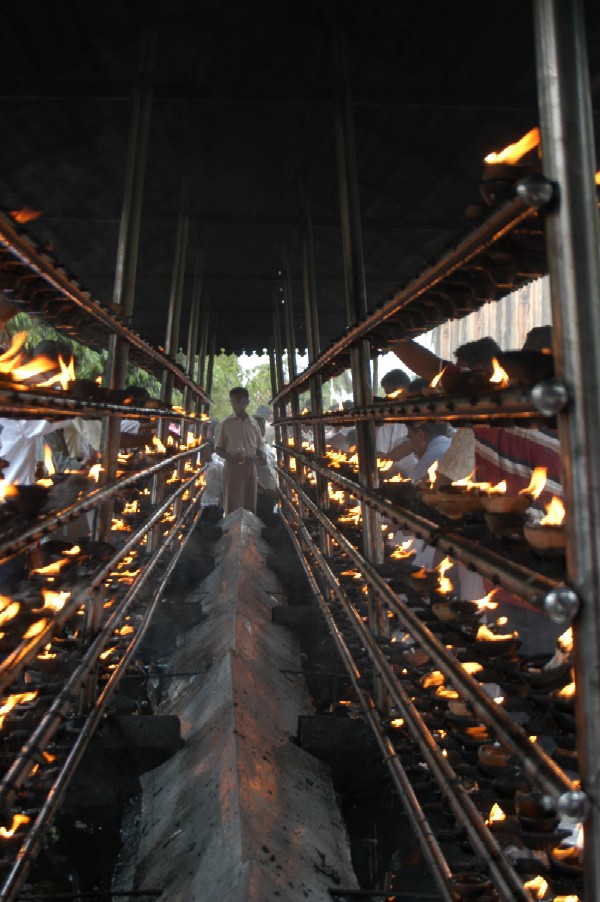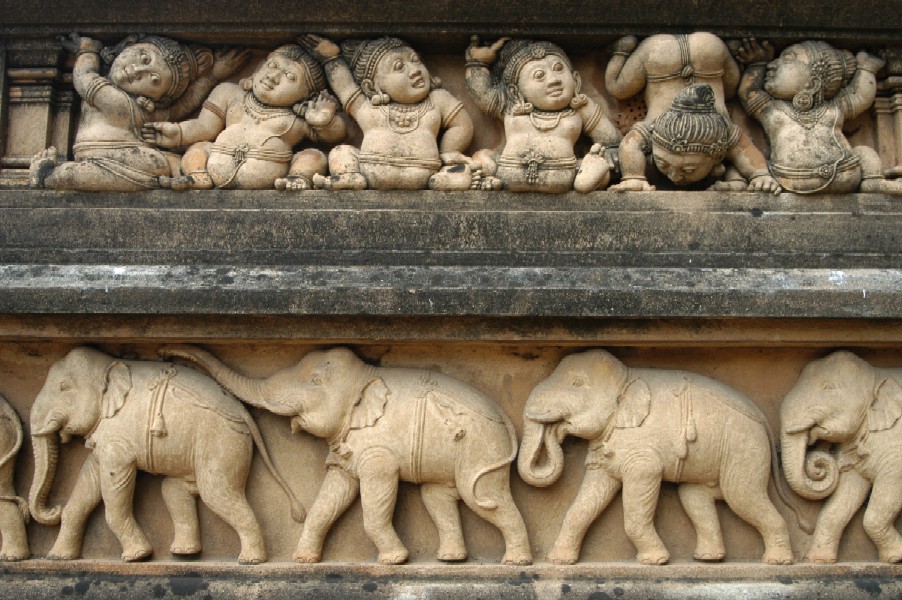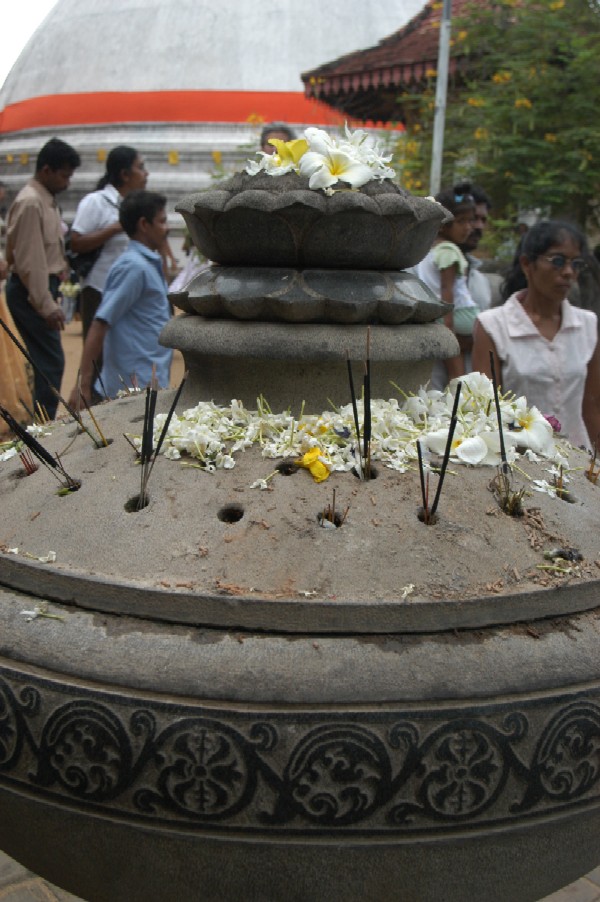October 27. COLOMBO "Poya Day at Kelaniya Raja Maha Temple" Sri Lanka is a dominantly Buddhist country with 70% of the people following the Theravadan school of Buddhist philosophy. From Sri Lanka the Theravadan form of the religion spread to Thailand, Burma, Laos, Cambodia, and parts of Vietnam. Hinduism accounts for about 15% of the population, mainly the Tamils in the north, Muslims make up about 9%, and Christians about 7.5% of the population. Various religious holidays are celebrated throughout the year but each month the Buddhists celebrate Poya Day, full-moon day. Worshippers visit temples from dawn until dusk on Poya day, making offerings and listening to sermons, and the normal pace of daily life slows down. Alcohol is not supposed to be consumed or sold on Poya Days, shops and some restaurants are closed, and transportation gets flooded with people going to and from the temples. We decided to visit the Kelaniya Raja Maha Temple outside Colombo on Poya Day, the site where Buddha is said to have preached 2000 years ago. of the religion spread to Thailand, Burma, Laos, Cambodia, and parts of Vietnam. Hinduism accounts for about 15% of the population, mainly the Tamils in the north, Muslims make up about 9%, and Christians about 7.5% of the population. Various religious holidays are celebrated throughout the year but each month the Buddhists celebrate Poya Day, full-moon day. Worshippers visit temples from dawn until dusk on Poya day, making offerings and listening to sermons, and the normal pace of daily life slows down. Alcohol is not supposed to be consumed or sold on Poya Days, shops and some restaurants are closed, and transportation gets flooded with people going to and from the temples. We decided to visit the Kelaniya Raja Maha Temple outside Colombo on Poya Day, the site where Buddha is said to have preached 2000 years ago.
Before heading off on our Poya Day excursion we had breakfast at Le Palace, a beautiful cafe housed in an old mansion near our guesthouse in Cinnamon Gardens. The pastries were a bit expensive but sitting on the big veranda over coffee was a great start to the day. After breakfast we had to change lodgings. Our visas wouldn't be ready for a few more days and Parisare was booked. We had considered taking a short trip and coming back to Colombo for our visas but reconsidered since there was a chance our visas would be ready sooner. Changing lodgings was an inconvenience but we weren't that upset about it since the lack of privacy at Parisare was getting on our nerves. Instead we hired two tuk-tuks to haul us and our backpacks to Mrs. Padmini Nanyakkara's guesthouse, closer to Galle Road in the Kollupitiya area. The quaint little home with its overgrown garden was charming and the owners were very friendly, taking time to chat and get to know their guests. Our room was in a small apartment house next door, a kind of shared flat arrangement. Nanyakkara's guesthouse, closer to Galle Road in the Kollupitiya area. The quaint little home with its overgrown garden was charming and the owners were very friendly, taking time to chat and get to know their guests. Our room was in a small apartment house next door, a kind of shared flat arrangement.
After unloading our bags we grabbed another tuk-tuk up to the main Fort train station. We were going to buy train tickets for Friday so we had to option to leave if our visas were ready but the ticket office was already closed, a Poya Day inconvenience that our guidebook neglected to mention. But, it wasn't a wasted trip since buses for the temple left from near the station. We had to sit in the bus until it began to fill up but it never got completely packed with people. The ride to the temple took us about 7km outside Colombo. It seemed to take a while for just 7km, with all of the stopping and going, but it gave us a chance to see some of the outer reaches of Colombo. We passed Hindu temples, Christian churches, and Buddhist statues as the bus left the city. Colombo is a fairly small city, with only a handful of tall buildings, so the suburban area quickly gave way to more rural, but still heavily populated, surroundings. When we finally reached the temple the entire bus unloaded.
The temple stood on a small hill next to the road; a green park area led to the main gate. It was a bustling place with people coming and going from the temple, and eating and socializing in the park. The temple complex was smaller than I was expecting, consisting of a the main dagoba, a large white stupa, and a sm aller temple building. A small fountain at the main gate was everyone's first stop. They reached their flower offerings into the water spout for purification. Once inside the main gate we had to take off our shoes and go barefoot around the complex. Shoes were stacked up in every corner of the courtyard but we decided to stash ours in a plastic bag and take them with us. We wanted to be sure that we had them for the ride back to town. I wasn't thrilled about the idea of going barefoot in such a public area but there was no choice in the matter. Rob ran a reconnaissance trip into the main dagoba and confirmed that it was really worth the effort so I just tried not to think about how many bare feet had already trodden the path before me. It was a slow process to inch our way through the main dagoba, shuffling along with the never ending crowd of people, trying not to intrude on their religious activities. A long reclining Buddha was the highlight, ethereally obscured from view by a thin cloth but delicately lit and still recognizable. The floor was grainy from the sand that had been tracked in from outside and sticky from all of the sweaty feet but I just tried not to think about it. The humidity made crowded contact with all of the worshippers a rather wet experience but the heavy smells of flower offerings, incense, and sweaty people just added to the atmosphere. aller temple building. A small fountain at the main gate was everyone's first stop. They reached their flower offerings into the water spout for purification. Once inside the main gate we had to take off our shoes and go barefoot around the complex. Shoes were stacked up in every corner of the courtyard but we decided to stash ours in a plastic bag and take them with us. We wanted to be sure that we had them for the ride back to town. I wasn't thrilled about the idea of going barefoot in such a public area but there was no choice in the matter. Rob ran a reconnaissance trip into the main dagoba and confirmed that it was really worth the effort so I just tried not to think about how many bare feet had already trodden the path before me. It was a slow process to inch our way through the main dagoba, shuffling along with the never ending crowd of people, trying not to intrude on their religious activities. A long reclining Buddha was the highlight, ethereally obscured from view by a thin cloth but delicately lit and still recognizable. The floor was grainy from the sand that had been tracked in from outside and sticky from all of the sweaty feet but I just tried not to think about it. The humidity made crowded contact with all of the worshippers a rather wet experience but the heavy smells of flower offerings, incense, and sweaty people just added to the atmosphere. 
Exiting the dagoba we were facing a huge bodhi tree, encircled by a wall of images, pray flags streaming down through the branches. In front of the tree there was a large crowd of people dressed in white gowns all attentively listening to a dharma sermon. Behind them people were moving around the wall, making offerings to the stone images and waiting for their turn to deposit an offering of fresh water to a statue of Buddha on the back side of the tree. Facing the Buddha, at the rear of the complex, was a caged cauldron of hot oil with a spout extending beyond the cage for ongoing oil offerings. Next to the cauldron were rows of small clay oil lamps for more offerings. Next to the bodhi tree a smoking censor of fragrant incense smoldered away Water, oil, flowers, incense, lamp lighting; all offerings to the Lord Buddha.
We didn't see any other tourists around the complex but our presence didn't seem to draw much attention. People were happy and relaxed. We strolled slowly around the dagoba and stupa, sitting occasionally to just take in the hum of activity. Feeling that we'd had a good dose of Poya Day festivities we eventually made our way back to the buses. It was late in the afternoon and the flow of traffic was leaving the temple so people were scrambling to get seats on the bus. We caught a bus just as it was arriving and just managed to grab two single seats along the left side of the bus. As people squeezed inside it got more and more crowded. I had one guy nearly sitting on my shoulder as he leaned to hold on to the side of the bus. It wasn't exactly comfortable but at least I had a seat! The ride back to Colombo seemed to go more quickly and before we knew it we were back near the train station.
 With what was left of our day we took a tuk-tuk to the nearby St. Anthony's Church to observe pilgrims of a different faith. The church was built in a Portuguese style, the Portuguese controlled parts of Sri Lanka from 1505 until they were usurped by the Dutch in 1658. It wasn't quite as interesting as our guidebook led us to expect but was definitely a contrast to the Poya festivities at the Buddhist temple. We tried to have dinner at a fish restaurant in the Fort area but found it closed for Poya Day and ended up at the Palmyrah Restaurant inside a hotel along Galle Road. It was a bit pricey but the food was just okay. With what was left of our day we took a tuk-tuk to the nearby St. Anthony's Church to observe pilgrims of a different faith. The church was built in a Portuguese style, the Portuguese controlled parts of Sri Lanka from 1505 until they were usurped by the Dutch in 1658. It wasn't quite as interesting as our guidebook led us to expect but was definitely a contrast to the Poya festivities at the Buddhist temple. We tried to have dinner at a fish restaurant in the Fort area but found it closed for Poya Day and ended up at the Palmyrah Restaurant inside a hotel along Galle Road. It was a bit pricey but the food was just okay.
October 28 - 29. COLOMBO Our new lodging was okay and they served a decent breakfast in their garden but I woke up on our first morning with my feet covered in bites. I suspected they could have been from sand flies at the temple but there were more after our second night so I am pretty sure something was up with our bed. Otherwise the apartment was quiet and we were able to use the DVD player in the common room to watch a bootleg version of "Lost in Translation". We also met an interesting couple that was coming from India and headed to Africa. He was English and she was German. We had fun exchanging some stories and tips as we crossed paths.
With our last couple of days in Colombo we combed the city for guidebooks, visited just about every souvenir shop on our map, and ate well at various restaurants. Sakura and The Cricket Club Cafe were our favorites but was also tried the mundane but reasonably priced Deli Market inside the World Trade Center Building, which turned out to be a good place to sample different Sri Lankan foods in a comfortable environment. Barista Cafes were another popular stop for us, basically the Sri Lankan version of Starbucks. And, we had a nice lunch at the Barefoot Cafe. Since my last round of antibods in Ethiopia I was steering clear of street food. Trade Center Building, which turned out to be a good place to sample different Sri Lankan foods in a comfortable environment. Barista Cafes were another popular stop for us, basically the Sri Lankan version of Starbucks. And, we had a nice lunch at the Barefoot Cafe. Since my last round of antibods in Ethiopia I was steering clear of street food.
Our shopping efforts met with little success but Rob enjoyed perusing the gem exchange in the World Trade Center, Sri Lanka is famous for its gems. We used tuk-tuks frequently, which was sometimes a death defying experience, but we also tried to walk more of the city. Overall Colombo was a pretty comfortable place but after four full days we had really been there long enough. We were relieved when our visas were ready early and we were able to leave on Friday without needing to come back. |
SRI LANKA
Colombo
Oct 25
Oct 26
Oct 27-29
Nuwara Eliya
Oct 30
Oct 31
Kandy
Nov 1-5 (1)
Nov 1-5 (II)
Polonnaruwa
Nov 6
Sigiriya & Dambulla
Nov 7
Colombo
Nov 8
INDIA
Ft.Cochin
Nov 9-15 (I)
Nov 9-15 (II)
Nov 16
Nov 17-18
Madurai
Nov 19
Nov 20
Tiruchirapalli
Nov 21
Nov 22
Nov 23
Chennai
Nov 24
Nov 25-26
Nov 27-28
Ft.Cochin
Nov 29
Lakshadweep
Nov 30-Dec 4 (I)
Nov 30-Dec 4 (II)
Trans-India Train
Dec 5-7 (I)
Dec 5-7 (II)
Siliguri
Dec 8
Darjeeling
Dec 9
Dec 10-13
Dec 14
Sikkim
Dec 15
Dec 16-20
Dec 21-23
Dec 24
Dec 25
Darjeeling
Dec 26
Dec 27-Jan 2
Siliguri
Jan 3
Jaigon
(Bhutan)
Jan 4
Kolkata
Jan 5-6
THAILAND
Bangkok
Jan 6-13 (I)
Jan 6-13 (II)
Jan 6-13 (III)
|

